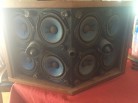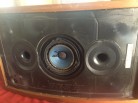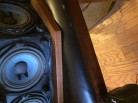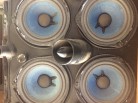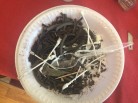Its fitting since today is Father's Day I'm going to post a article about my own Father's Day present. Normally this would be only a review, but since we're dealing with a classic set of speakers that needed a small amount of refurbishment prior to using them, its more of a voyage to achieve a goal. I came across these on a Craigslist ad. At $200 these were an absolute bargain. So at this point a lot of folks are going to wonder why I'd want to even look at these Bose 901 speakers.
Dr. Bose first released the original, or Series I, Bose 901 speakers in 1968. The current model is up to the Series VI. What made these speakers so different is that there are several identical drivers which face the wall and not the listening area. The sound is bounced off the wall, and ceiling, and floor, to the listener. Prior to surround systems Dr Bose figured out how to fill a room with smooth even sound. Generally in the audiophile community these speakers are vilified, not only for their sound but also for the EQ that Bose provides that is listed as absolutely necessary for good listening. To most audiophiles this means a speaker that can't sound good without it's own EQ, and worse, which doesn't sound good without the factory EQ.
Those concerns aside, I had the opportunity to work on a set of these speakers many years ago. I was blown away by their heavy duty construction as well as their output once I finished repairing them. I found them to be extremely efficient. With over 100 watts pumping into them they were crystal clear. No distortion from any of these speakers even as the volume knob reached for max. Of course the amplifier was creating some THD which the speakers did an incredible job of not distorting any further.
The purchase and concept
I've covered the power handling of 901's at 100 watts. Whats more impressive is that these speakers love power. The more input they get the sweeter their sound. I found the owner's manual online for these Series III units and there is an interesting line. With amplifiers at 100 watts or less no fusing is necessary. For amplifiers over 100 watts a 3 amp fast blow fuse is recommended. The manual also mentions that peaks of 250 watts are within specs. The particular units I worked on previously were running in a huge room behind a 300 watt amplifier. What's more, it often ran to the point where the amp overheated and had to be turned off to cool. After all this abuse you'd think the speakers would be trashed but all they showed was deterioration of the foam surrounds on the speakers. The paper cones themselves were perfect. 901's and the similar 802 speakers have a history of deteriorating foam surrounds soI kind of think of this as the fuse that prevents the cones from being destroyed but with a peak handling of 250 (conservative number from Bose) its impressive that any speaker could survive.
The units I found did not come with their factory EQ or stands. Bose is absolutely specific that the EQ must be used with them. Consider that the EQ can limit bass and change mid range response. A modern EQ is more than capable of doing this as the factory unit basically clips the output to certain frequencies. Online forums basically say adjust your EQ to have a smiley face. This boosts bass and treble which is a universal complaint for these speakers. Guess what, I think one of the most useful applications would be in a multi-channel surround system. Today, our surround systems direct certain frequencies to specific speakers. A speaker with fantastic mid-range output sounds like a perfect replacement for the crappy speakers most systems come with for their left and right channels. Luckily most systems already have a subwoofer with adjustable output, a center channel, and rear channels. Improving the mid range will improve the entire sound of a room and so I embarked on my mission with these speakers despite the missing EQ and stands.
The Repair
One thing immediately obvious with these speakers was the fantastic shape of the wood cabinet. No damage on any of the corners. That's amazing for a speaker that's about 40 years old. What's more, the bottoms had never had screws put in them. Stock these come with stands so why they were never mounted is beyond me but a speaker falling from a stand is the most frequent cause of damage to any speaker shell. I couldn't take the screen fabric off until I got home since they are secured with staples in the front and glue in the back but judging from the shells I kept my fingers crossed and I wasn't disappointed once I did take off the fabric. Every last foam surround was completely deteriorated but the paper cones and spiders of the speakers were perfect. No corrosion was a nice find as well as completely intact plastic shell. More on that later.
The refoaming kit came with the speakers as well as a couple of two way crossovers. I think the original owner planned to use the crossovers to limit what tones reached these speakers. I think he was going to use a more conventional left and right speaker arrangement with maybe a couple of tweeters to enhance top end. Not my plan but the foam repair kit included was top notch - equal to what I've used in the past so it was time to dive in to the repair. Check out the gallery pictures below for the before and after pics. The kit includes a DVD with instructions. I didn't view it as I have a technique of my own. Mine? Prepare the speaker foam by placing it upside down on the speaker and glue up the crevice the paper cones will occupy. After you are ready to flip them put glue on the speaker surround simultaneously. Lots of people do that as a later stage. Next I drop the foam on and move the cone in and out to make sure its not rubbing. Now my big trick? I use a disposable plastic spoon to push the foam on. Its rounded shape helps tremendously with the repair. Lastly press the outside edge down firmly. Last trick? Let the glue reach the consistency of tooth paste. Too wet and you'll have a hell of a time getting it to work without losing your mind. There easy right? Nope, took about 5 hours since there are 18 speakers altogether. Cleaning the surface helps dramatically but you then you have to let the glue set up for about 3 or more hours. I tested them at 3 hours to ensure there were no buzzes or loose foam but let the glue cure overnight.
How do they sound?
In a word, fantastic. First song up was Andrea Bocelli's Con te partiro. Pure vocal bliss ensued. Next was the Commander-in-Chief and Thomas Valeur's Zigeunerweisen, Op. 20. Fantastic clear mids and highs. Now I cued up deadmau5 and Kaskade's I Remember. Terrible. The bass sounded bizarre and something just didn't sound right. The more I worked on adjusting my settings the more I realized what the problem was. Too much audio compression. Compression makes sure the softest tones are equally loud to the loudest, and keeps those high volume sounds going much longer than they naturally would. Don't know what I mean? Here's a great article on the subject with compressed and uncompressed versions of the same songs. What I find is that all this compression sounds better on very small speakers - earbuds and the like. Go to a full sized system like I'm trying to use and the oddities are very obvious - also the tiring aspect of listening to compressed music really stands out.
To really check this out I played Van Halen I. One of my favorite albums. The recording engineers on this album did a great job and it still shows nearly 40 years later. Next I listened to the latest Van Halen album which has that Tattoo song on it. "Modern" compression is so high on that song its like an audio assault. And not in a good way. A small amount of compression can be fantastic at balancing the loudest and softest sounds on a song. Go to the extreme and my ears can handle it for only a few minutes. Its exhausting to have your ear drums moving that much to listen to a song.
The first Blueray I cued up was the latest Star Trek movie. Fantastic sounds came forward. If all you were going to do with these speakers was use them with a 5.1 or 7.1 surround system to watch movies you won't be disappointed. Remember I wanted to see if the EQ from the factory was that critical to the equation? In a system that sends certain frequencies to each speaker it just isn't needed. You aren't trying to capture the deepest bass and with a little EQ tweaking you'll be very happy. Next I put in Bullitt. Why not watch a movie from 1968 - the same year the Bose 901 was released. The surround effect is only a 2 channel recording even though its on Blueray. Surprisingly I really enjoyed the audio - the subtle jazz soundtrack, the roar of American V8 engines in a chase, and the squeel of bias ply tires came right through the screen and grabbed me. Lastly I put in Whiplash - the Academy Award winning movie about a young jazz drummer. The music was outstanding. So clear, so natural. The string bass resonated without being obnoxious but the mids and highs were just so natural. If felt like I was sitting in the audience during the performance scenes. Being someone who used to sit in the orchestra its wonderful to be engulfed by the music again.
Last thoughts
A speaker that directs 8 drivers to the wall and only one directly at the listener doesn't seem natural. I can guarantee you that the design fills the room but left and right channels are still identifiable. Imagine sitting at a concert with your eyes closed. You're surrounded with the sound but left, right, center, and rear are all clearly heard. In a home multi channel setup there is a center channel, subwoofer, and rear speakers these speakers make a phenomenal contribution.
As far as selecting 901 I'd look for Series III to the latest Series VI. Beginning with the series three you get eight rear firing speakers and the three port design. Earlier speakers feature fewer drivers and those speakers just can't compare to the latest designs. The lack of ports also hurts certain tonal ranges. Beyond that its up to you if you want to change the grill cloth. I kept the original cloth as I really liked the way its dark color complemented my entertainment center.
Functionally you need to have clear wall behind the speakers. If there is a soft material like curtain you lose the reflection ability. Knowing that I wouldn't place soft materials to the side either. If you decide you want the EQ from the factory but the speakers you found don't have it you can use a Series II EQ for Series I and II speakers, a series IV EQ for series III and IV, and a series VI, which you can still get from Bose, for series V and VI. You'll need a stereo capable of looping in the EQ.
Too often audiophiles are stuck in one listening possibility. A two speaker setup with a record player is probably the least common stereo configuration so why limit a good set of speakers to these layouts? Sadly, modern speakers are often too small or poorly made to hear the nuances that were recorded by the artis. Somehow we've been programmed to accept this sub par sound as the norm. Finding a used set of 901's for $200 to $400 is totally doable and if you don't like them turn around and sell them to someone else. I doubt you'll hate them but to each their own. I'll keep enjoying this full spectrum sound. I just need some good speaker stands that can hold their weight as modern stands are often rated to 16 lbs or less. I don't know that I'll get a pair of the stock stands as those have a cool mid century vibe which just won't work with my furniture. As for the need for the EQ I think that is totally unnecessary. Bose list the 901 as their flagship speaker and they are still in production all these years later. My Series III speakers are probably from the mid-70's but they exceeded my expectations.
Bose 901 Saga
By
Oleg Mitskaniouk |
Posted
November 22, 2022
at
04:22PM
Description
Full range 9 driver speaker.
8 ohms
Approx $1400 USD from Bose
8 ohms
Approx $1400 USD from Bose
Rating
Summary
Pros
Used 901's are a fantastic value
Cons
Far less bass than modern sounds, but that's what a subwoofer is for
Latest news
-
Could the Computer Age Have Begun in Victorian England?
By Victor Oshiro
Posted October 31, 2022 at 11:28AM -
Is there a savant inside all of us?
By Elena Ananieva
Posted October 4, 2022 at 12:17PM -
Teaching an old dog new tricks: How to fix Microsoft
By Oleg Mitskaniouk
Posted September 25, 2022 at 12:45PM -
How the brain filters bad news
By Oleg Mitskaniouk
Posted September 25, 2022 at 12:30PM
Latest reviews
-
Kwikset 909 Electronic Deadbolt
By Victor Oshiro
Posted November 7, 2022 at 09:28AM -
ViewSonic SC-U25 VDI Client
By Victor Oshiro
Posted October 31, 2022 at 01:30PM -
AEE S71T Plus
By Oleg Mitskaniouk
Posted October 26, 2022 at 01:38PM -
Userful MultiPlatform Virtual Desktop
By Victor Oshiro
Posted October 26, 2022 at 11:29AM
